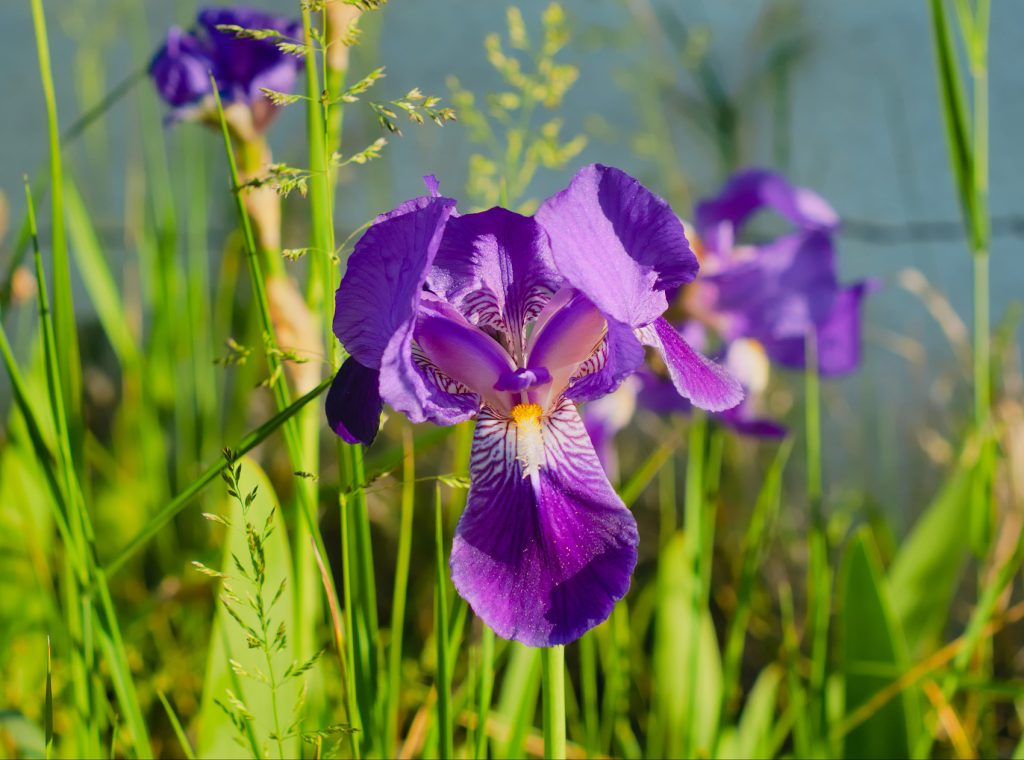There’s More to Irises Than Meets the Eye
Irises have long charmed gardeners and nature lovers with their striking colors and delicate petals. But these beautiful blooms offer much more than just good looks. From ancient symbolism to modern uses, the iris is a flower packed with history, meaning, and even a few surprises.
1. A Symbol of Power and Prestige
The iris has been a symbol of royalty and strength throughout history. One of its most famous associations is the fleur-de-lis, a stylized version of the iris used by the French monarchy. But its royal connections don’t end there. In ancient Egypt, irises were so highly valued that their images were even carved into monuments like the Great Sphinx.
During the Middle Ages, irises adorned castles and palaces across Europe, reinforcing their image as a flower of nobility and influence.
2. Rooted in Greek Myth
The name “iris” comes from Greek mythology. Iris was the goddess of the rainbow and a divine messenger, often traveling between heaven and earth on a rainbow. Her role as a connector of worlds is echoed in the flower’s diverse colors, symbolizing the many hues of a rainbow.
Her mythological ties to both sea and sky—through her parents, Thaumas and Electra—reflect the iris flower’s rich and varied character.

3. Deep Roots in Japanese Tradition
In Japan, irises (called shobu no hana) represent strength and protection. The country has cultivated thousands of iris varieties over the centuries, especially during the Edo period, when iris breeding flourished.
You’ll often find irises in Japanese paintings, crafts, and flower arrangements. They also play a role in cultural traditions—on May 5th, iris leaves are placed in baths during Boy’s Day celebrations, believed to bring good health and ward off evil spirits.
Tokyo’s Horikiri Iris Garden remains a popular spot for admiring these blooms, featuring over 6,000 plants in peak season.
4. The Scent Hidden Underground
Interestingly, the fragrant part of the iris isn’t the flower—it’s the root. Known as orrisroot, it comes from the Iris pallida species. After aging for several years, these roots develop a scent often described as powdery and violet-like, making them a prized ingredient in luxury perfumes.
High-end fragrance houses use iris essence to create rich, sophisticated scents that range from floral to woody to powdery, depending on the blend.
5. Spiritual Symbolism in Christianity
In Christian iconography, the iris is closely linked to the Virgin Mary, symbolizing her purity and sorrow. Its pointed leaves are said to resemble swords, reflecting Mary’s suffering.
The flower’s three petals also carry spiritual meaning, often representing faith, wisdom, and valor, or symbolizing the Holy Trinity: the Father, Son, and Holy Spirit.
This spiritual symbolism influenced the fleur-de-lis, further strengthening the flower’s association with royalty and divinity.
6. What Makes Irises Biologically Unique
An iris flower has six lobes—three petals and three sepals—which often look similar and are sometimes called “tepals.” These colorful parts are arranged in a way that’s both visually appealing and functional, guiding pollinators right where they need to go.
Irises come in a wide variety of colors and can grow in all sorts of environments, from dry gardens to marshy areas. This adaptability has helped them flourish worldwide.

7. A Role in Traditional Medicine
Irises have been used for centuries in herbal medicine. Ancient Egyptians and Greeks believed that iris rhizomes had healing properties. They were used to reduce swelling, treat skin issues, relieve coughs, and even promote urination.
While not common in modern medical treatments, these historical uses show just how deeply irises have been intertwined with human wellness.
A Flower Steeped in History and Culture
Across ancient civilizations, irises have always stood out. In Egypt, they were a royal symbol. In Greece, they were named after a goddess. In medieval Europe, they appeared on flags and family crests as a mark of nobility.
They’ve also inspired countless works of art. From Roman frescoes to Leonardo da Vinci’s religious paintings and Van Gogh’s vibrant “Irises,” these flowers have been a muse for generations.
What Science Says About Irises
Irises have fascinating traits that help them survive and spread. Their distinct shape—with three upright petals (“standards”) and three hanging ones (“falls”)—makes pollination easier. Some species have fuzzy “beards” that help guide insects to the nectar.
They reproduce both through seeds and rhizomes, which gives them a better chance of survival. Some even have special adaptations like waxy leaves or salt tolerance to thrive in tough environments. Their roots store water and nutrients, making irises incredibly resilient.
They also form helpful partnerships with fungi in the soil, which boost their nutrient intake—a great example of how nature works together.

Irises in Today’s World
Irises are just as captivating now as they were centuries ago. Artists still use them as inspiration in paintings, sculptures, and photography. Their beauty, complexity, and variety make them a symbol of elegance, creativity, and strength.
Modern meanings of the iris include:
- Hope and renewal
- Personal growth
- Strength through adversity
- Connection to nature and biodiversity
Iris tattoos are gaining popularity for those reasons too—many see them as a symbol of overcoming challenges and blooming into one’s own.
Final Thoughts: More Than Just a Pretty Flower
Irises are a perfect mix of beauty, history, and resilience. They attract pollinators, beautify landscapes, and carry layers of cultural meaning—from ancient myths to royal emblems.
Whether in your garden, in art, or as a symbol of inner strength, irises remind us that nature is full of hidden depth and timeless inspiration. They show us how something as simple as a flower can tell a powerful story.












